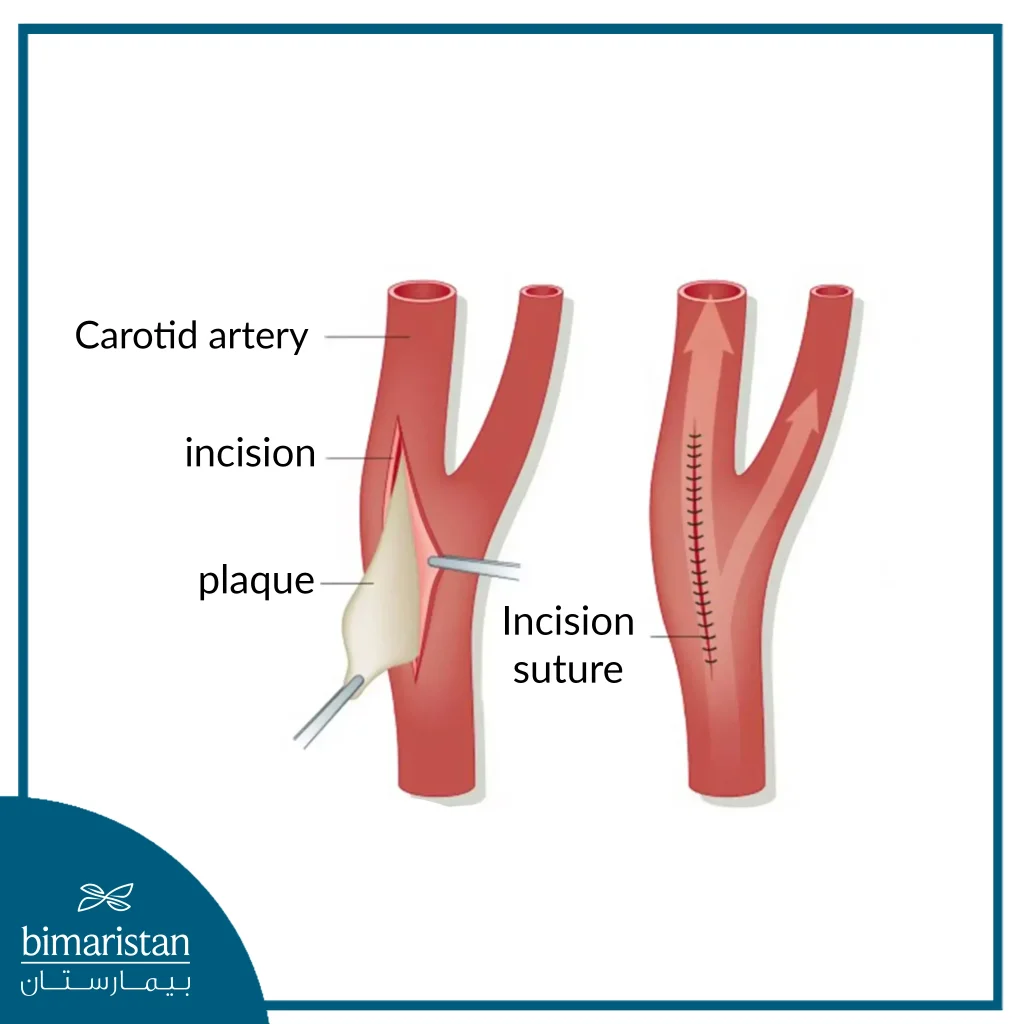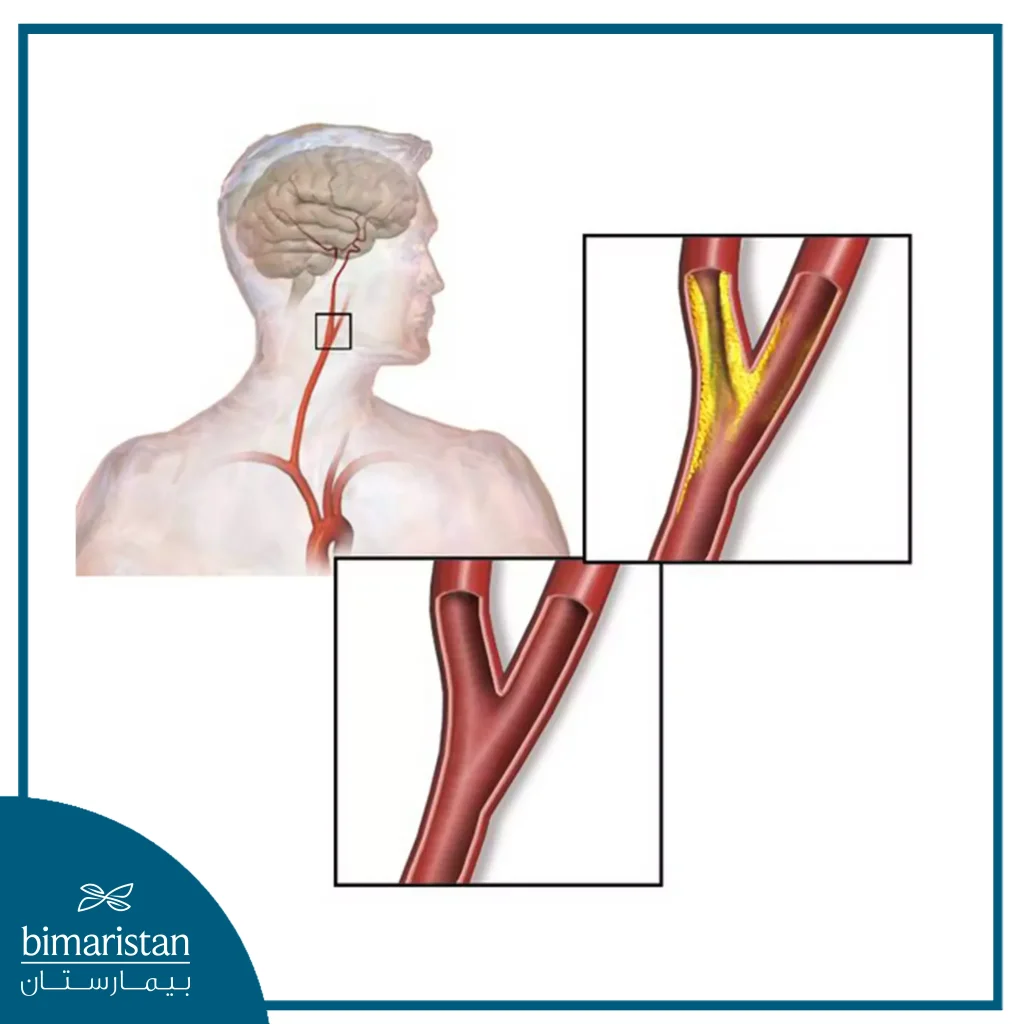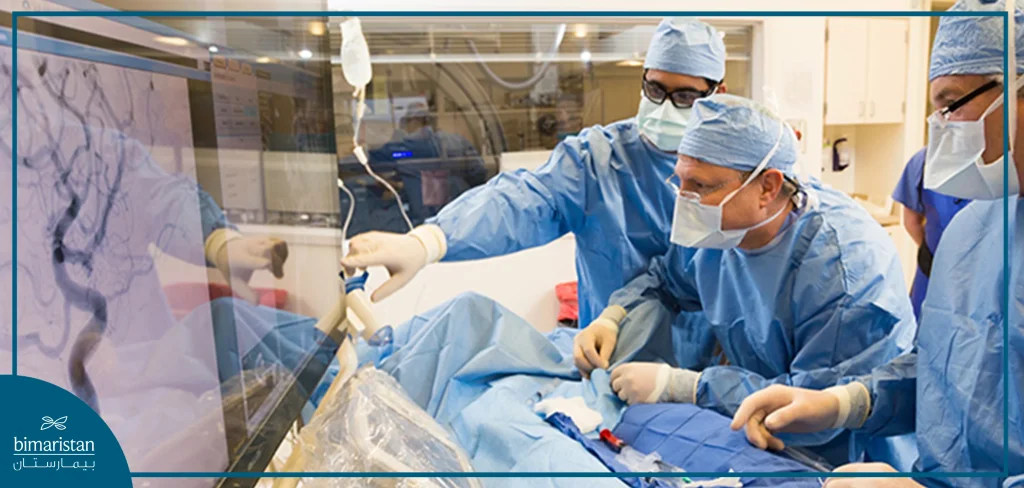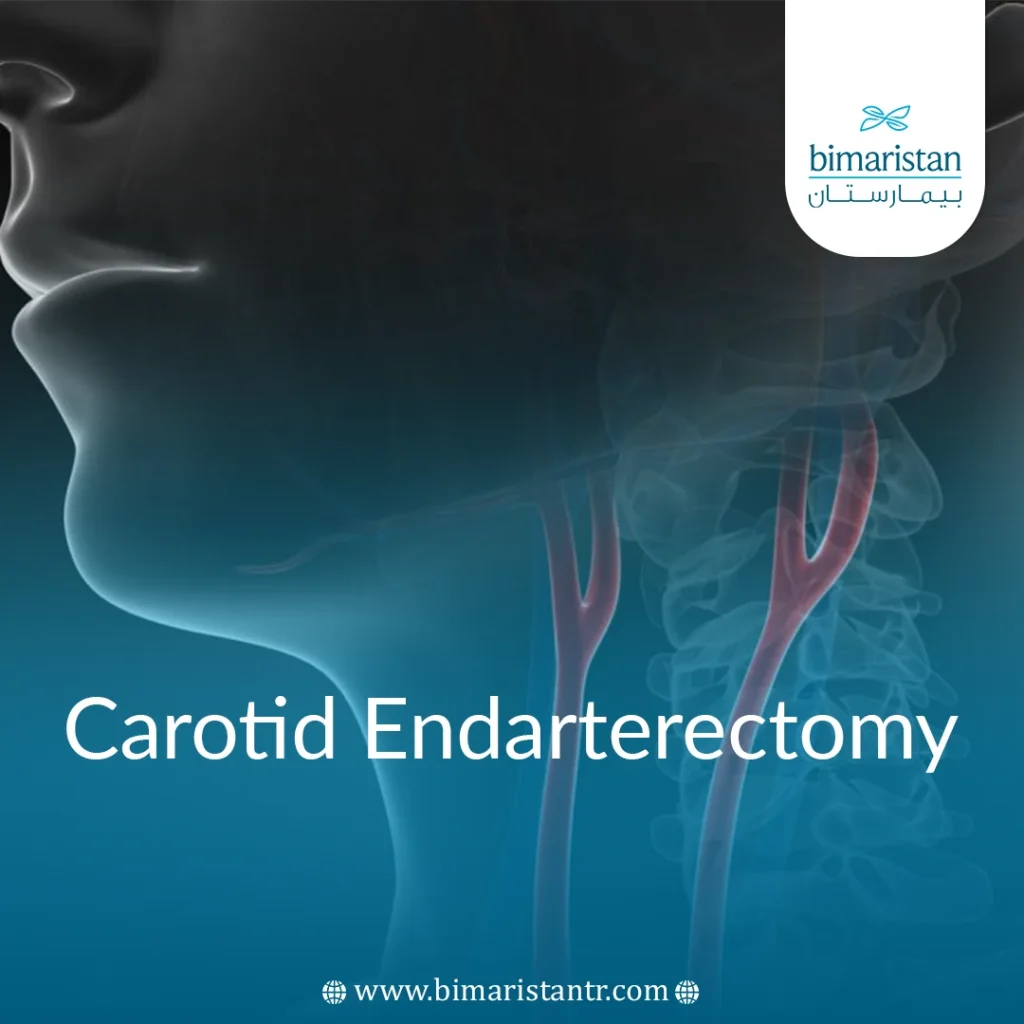Stroke is the leading cause of death worldwide, with approximately 795,000 strokes occurring annually in the United States alone. Carotid endarterectomy is highly effective; studies have shown that it reduces the risk of stroke by up to 55% in patients with severe carotid artery stenosis.
What is carotid endarterectomy?
Carotid endarterectomy (CEA) is a surgical procedure to treat carotid artery disease. The carotid arteries are the main blood vessels that carry oxygen and blood to the brain. In carotid artery disease, these arteries narrow, reducing blood flow to the brain and causing a stroke.
When brain damage occurs, a healthcare provider will surgically remove plaque that has built up inside the internal carotid artery. He or she will perform the endarterectomy by making a cut (incision) in the side of your neck above the affected carotid artery. The artery is opened, and the plaque is removed. Your healthcare provider will sew the artery back together. This restores normal blood flow to your brain. You may have the procedure while you are awake under local anesthesia or while you are asleep under general anesthesia.

Why might I need a carotid endarterectomy?
A carotid endarterectomy is a procedure done to treat the narrowing of the carotid artery due to atherosclerosis. This is a buildup of plaque in the inner lining of the artery. Plaque comprises fatty materials, cholesterol, cellular waste products, calcium, and fibrin. Atherosclerosis is also called “atherosclerosis.” It can affect arteries throughout the body. Carotid artery disease is similar to coronary artery disease. In coronary artery disease, blockages form in the arteries of the heart and can cause a heart attack. In the brain, it can lead to a stroke.
The brain needs a constant supply of oxygen and nutrients to function properly.
Even a brief interruption in blood supply can cause health problems. Brain cells begin to die after just a few minutes without blood or oxygen.
If the narrowing of the carotid artery becomes severe enough to block blood flow, or if a piece of plaque breaks off and blocks blood flow to the brain, a stroke called a ministroke (transient ischemic attack or TIA) can occur. The symptoms are similar to those of a stroke and last from a few minutes to a few hours. A TIA may be the first sign of the disease.
You may not have symptoms if you have carotid artery disease. Plaque buildup may not block enough blood flow to cause symptoms. An artery that is partially blocked, 50% or less, often causes no symptoms.
Your healthcare provider may have other reasons to recommend a carotid endarterectomy.

What are the risks of carotid endarterectomy?
Some potential complications of carotid endarterectomy include:
- Stroke or TIA
- Heart attack
- Blood pooling in the tissues around the incision site, causing swelling
- Nerve problems with certain functions of the eyes, nose, tongue, or ears
- Bleeding in the brain (intracerebral hemorrhage)
- Seizures (uncommon)
- Recurrent carotid artery blockage. Or a new blockage that develops in the artery on the other side of your neck.
- Bleeding at the incision site in your neck
- Infection
- High blood pressure
- Irregular heartbeat
- Airway obstruction from swelling or bleeding in the neck
If you are allergic to medicines, contrast dye, iodine, or latex, tell your healthcare provider. Also, tell your healthcare provider if you have kidney failure or other kidney problems.
There may be other risks depending on your condition. Discuss any concerns with your healthcare provider before the procedure.
How do I prepare for a carotid endarterectomy?
- Your healthcare provider will explain the procedure to you, and you can ask questions.
- You will be asked to sign a consent form that gives permission for the procedure. Read the form carefully and ask questions if anything is unclear.
- Your health care provider will review your medical history and perform a physical exam to make sure you are in good health before the procedure. You may have blood tests or other diagnostic tests.
- Tell your healthcare provider if you are sensitive or allergic to any medications, iodine, latex, tape, contrast dye, or anesthesia.
- Tell your healthcare provider about all prescription and over-the-counter medications and herbal supplements you are taking.
- Tell your healthcare provider if you have a history of bleeding disorders. Also, tell your provider if you are taking any blood-thinning medications (anticoagulants), aspirin, or other medications that affect blood clotting. You may be asked to stop some of these medications before the procedure.
- If you are pregnant or think you might be pregnant, tell your healthcare provider.
- Follow the instructions you were given not to eat or drink before your surgery.
- Your health care provider may order a blood test before your procedure to see how long it takes your blood to clot.
- You may be given medicine (a sedative) before your procedure to help you relax.
- Tell your healthcare provider if you have a pacemaker.
- If you smoke, stop smoking as soon as possible before your procedure. This may help you recover faster. It may also improve your overall health. Smoking increases your risk of blood clots.
- Depending on your condition, your healthcare provider may give you other instructions for preparing.
What happens during a carotid endarterectomy?
Carotid endarterectomy requires a hospital stay. The procedure may vary depending on your condition and your healthcare provider’s practices.
In general, a carotid endarterectomy (CEA) follows this process:
- You will be asked to remove any jewelry or other items that might interfere with the procedure.
- You will undress and wear a hospital gown.
- You will be asked to empty your bladder before the procedure.
- An intravenous line will be started in your arm or hand. Another catheter will be placed in your wrist to monitor your blood pressure and take blood samples. One or more additional catheters may be placed in your neck, opposite the surgery site, to monitor your heart. Other catheter locations include the area below your collarbone and in your groin.
- If there is a lot of hair at the surgery site, your healthcare team may shave it.
- You will be positioned on the operating table, lying on your back. Your head will be slightly elevated and turned away from the side to be operated on.
- A catheter will be inserted into your bladder to drain urine.
- The anesthesiologist will check your heart rate, blood pressure, breathing, and blood oxygen levels during surgery.
- A CEA can be done under local anesthesia. You will be sleepy, but you won’t be able to feel the area being operated on. You’ll be given a sedative through an IV before the procedure to help you relax. This allows your healthcare provider to monitor what you’re doing during the procedure by asking you questions and testing your hand grip strength.
- If a CEA is done under local anesthesia, your healthcare provider will provide you with continuous support and keep you comfortable during the procedure. You’ll be given pain medication as needed.
- Under local anesthesia, you’ll be given oxygen through a tube that’s placed in your nose.
- A CEA can also be done under general anesthesia. This means you’ll be asleep. Once you’re sedated, your provider will put a breathing tube down your throat and into your windpipe to supply air to your lungs. You’ll be connected to a ventilator. This machine will breathe for you during the surgery.
- You will be given a dose of antibiotics through an IV to help prevent infection.
- The healthcare team will clean the skin over the surgery site with an antiseptic solution.
- The healthcare provider will make a cut (incision) down the side of your neck over the affected artery. Once the artery is exposed, the provider will cut the artery.
- The healthcare provider may use a device called a shunt to divert blood flow around the surgery area, keeping blood flowing to the brain. The shunt is a small tube that is inserted into the carotid artery to send blood flow around the area being operated on.
- With a blood shunt, the healthcare provider removes the plaque from the artery.
- The provider will then remove the shunt and carefully close the artery. The incision in your neck is stitched together.
- A small tube (drain) may be placed in your neck. This will drain any blood into a small suction bulb about the size of your palm. It is generally removed the morning after the procedure.
- You may get blood pressure medication through your IV during and after the procedure to keep your blood pressure in a certain range.
- If you have general anesthesia, your healthcare provider will wake you up in the operating room to make sure you can answer questions.
- A sterile dressing or bandage is placed over the surgical site.

What happens after a carotid endarterectomy?
In the hospital
After the procedure, you will be taken to the recovery room. Once your blood pressure, pulse, and breathing are stable and you are awake, you may be taken to the intensive care unit (ICU) or your hospital room.
In time, you will be helped out of bed to walk around as much as you can tolerate.
If a drainage tube was placed in the incision during the procedure, your healthcare provider will likely remove it the next morning.
You will be offered solid foods as you can handle them.
Take pain medication as recommended by your health care provider. Aspirin or certain other pain medications may increase the chance of bleeding. Be sure to take only the medications recommended.
Your healthcare provider may schedule a follow-up duplex ultrasound to monitor the carotid artery in your neck. This will be done annually to make sure plaque has not built up again.
Generally, you can go home within one to two days after a carotid endarterectomy.
At home
Once you return home, it is important to keep the incision area clean and dry. Your healthcare provider will give you specific instructions for bathing. If stitches were used, they will be removed during your follow-up office visit. If adhesive tapes were used, keep them dry, and they will fall off in a few days.
You can return to your normal diet unless your healthcare provider tells you otherwise. A diet low in fat and cholesterol is generally recommended. You should eat vegetables, fruits, low-fat or fat-free dairy products, and lean meats. Avoid processed or packaged foods.
You are usually allowed to drive once you stop taking pain medications and can easily turn your head to check your surroundings on the road and safely merge with traffic.
Tell your healthcare provider to report any of the following:
- Fever or chills
- Redness, swelling, bleeding, or other drainage from the incision site
- Increased pain around the incision site
Procedure results
Your doctor will discuss the results of the procedure with you. For most people,
This procedure helps prevent further brain damage and reduces the risk of stroke. However, unless patients adopt a healthier lifestyle, plaque buildup, clot formation, and other problems in the carotid artery can return.
Sources:
- Johns Hopkins Medicine
- Society for Vascular Surgery

